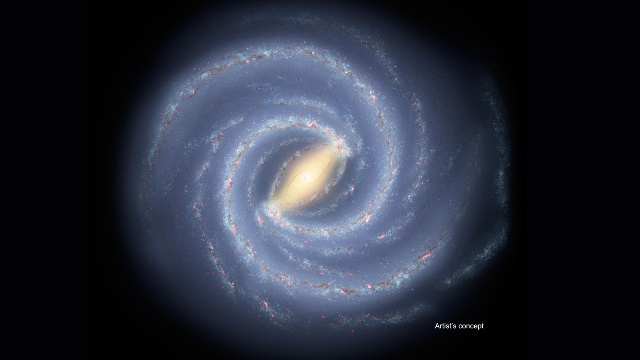Feb 28 2015
Astronomers using data from NASA's Wide-field Infrared Survey Explorer, or WISE, have found a cluster of stars forming at the very edge of our Milky Way galaxy.
 The newfound young star clusters lie thousands of light-years below the plane of our Milky Way galaxy, a flat spiral disk seen in this artist's conception. If alien lifeforms were to develop on planets orbiting these stars, they would have views of a portion, or all, of the galactic disk. Image credit: NASA/JPL-Caltech
The newfound young star clusters lie thousands of light-years below the plane of our Milky Way galaxy, a flat spiral disk seen in this artist's conception. If alien lifeforms were to develop on planets orbiting these stars, they would have views of a portion, or all, of the galactic disk. Image credit: NASA/JPL-Caltech
"A stellar nursery in what seems to be the middle of nowhere is quite surprising," said Peter Eisenhardt, the project scientist for the WISE mission at NASA's Jet Propulsion Laboratory in Pasadena, California. "But surprises turn up when you look everywhere, as the WISE survey did."
The discovery, led by Denilso Camargo of the Federal University of Rio Grande do Sul in Porto Alegre, Brazil, appears in a new study in the journal Monthly Notices of the Royal Astronomical Society.
The Milky Way, the galaxy we live in, has a barred spiral shape, with arms of stars, gas and dust winding out from a central bar. Viewed from the side, the galaxy would appear relatively flat, with most of the material in a disk and the central regions.
Using infrared survey images from WISE, the team discovered two clusters of stars thousands of light-years below the galactic disk. The stars live in dense clumps of gas called giant molecular clouds.
This is the first time astronomers have found stars being born in such a remote location. Clouds of star-forming material at very high latitudes away from the galactic plane are rare and, in general, are not expected to form stars.
"Our work shows that the space around the galaxy is a lot less empty that we thought," said Camargo. "The new clusters of stars are truly exotic. In a few million years, any inhabitants of planets around the stars will have a grand view of the outside of the Milky Way, something no human being will probably ever experience."
To learn more about the discovery, and what might have caused the stars to form at the edge of our galaxy, read the Royal Astronomical Society news release at: http://bit.ly/1ASpUYK
JPL managed and operated WISE for NASA's Science Mission Directorate. The spacecraft was put into hibernation mode in 2011, after it scanned the entire sky twice, completing its main objectives. Edward Wright was the principal investigator and is at UCLA. In September 2013, the WISE spacecraft was reactivated, renamed NEOWISE and assigned a new mission to assist NASA's efforts to identify the population of potentially hazardous near-Earth objects. Science operations and data processing take place at the Infrared Processing and Analysis Center at the California Institute of Technology in Pasadena.
The WISE mission was selected competitively under NASA's Explorers Program managed by the agency's Goddard Space Flight Center in Greenbelt, Maryland. The science instrument was built by the Space Dynamics Laboratory in Logan, Utah. The spacecraft was built by Ball Aerospace & Technologies Corp. in Boulder, Colorado. Caltech manages JPL for NASA.
More information is online at: http://www.nasa.gov/wise
Source: http://www.jpl.nasa.gov/